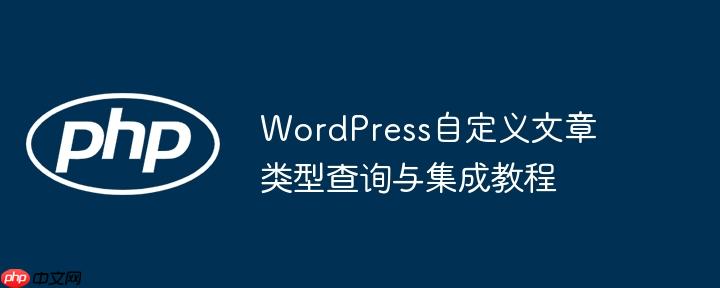
理解WordPress查询机制 (WP_Query)
wordpress的核心内容检索机制是通过wp_query类实现的。它允许开发者以高度灵活的方式从数据库中查询文章、页面、自定义文章类型等内容。通过向wp_query传递一组参数($args),我们可以精确地定义需要获取哪些内容、如何排序、每页显示多少等。
在许多插件和主题中,内容循环通常会接收一个预先构建好的WP_Query对象。例如,在提供的loop-post.php文件中,可以看到它接收$the_query作为参数:
// loop-post.php 示例片段
$the_query = isset( $args['template_args']['the_query'] ) ? $args['template_args']['the_query'] : '';
// ...
if ($the_query && $the_query->have_posts()) {
// ... 循环显示文章 ...
}这意味着要改变循环显示的内容,我们需要修改这个$the_query对象,或者在它被传递到loop-post.php之前,用我们自己的自定义查询替换它。
构建自定义文章类型查询
要查询特定的自定义文章类型,最关键的参数是post_type。以下是如何构建一个查询,以获取名为properties的自定义文章类型为例:
'properties', // 指定要查询的自定义文章类型,例如 'properties'
'post_status' => 'publish', // 只获取已发布的文章
'posts_per_page' => 8, // 每页显示8篇文章
'orderby' => 'title', // 按标题排序
'order' => 'ASC', // 升序排列
// 更多参数可以根据需求添加,例如:
// 'category_name' => 'featured', // 按分类名称查询
// 'tag' => 'new-arrival', // 按标签查询
// 'author' => 1, // 查询特定作者的文章
// 'tax_query' => array( ... ), // 复杂的分类法查询
// 'meta_query' => array( ... ), // 复杂的自定义字段查询
);
// 实例化 WP_Query 对象
$custom_the_query = new WP_Query( $custom_query_args );
// 以下是循环示例,展示如何使用这个查询对象
if ( $custom_the_query->have_posts() ) :
while ( $custom_the_query->have_posts() ) : $custom_the_query->the_post();
// 在这里可以调用模板片段或直接输出内容
echo '' . get_the_title() . '
';
the_excerpt();
// ... 其他内容,如缩略图、链接等
endwhile;
// 恢复全局文章数据,非常重要
wp_reset_postdata();
else :
echo '没有找到任何属性。
';
endif;
?>WP_Query常用参数详解:
- post_type (字符串或数组): 指定要查询的文章类型。默认是'post'。可以传入自定义文章类型的名称(如'properties'),或一个数组来查询多种文章类型(如array('post', 'page', 'properties'))。
- post_status (字符串或数组): 指定文章状态。常用值有'publish'(已发布)、'pending'(待审核)、'draft'(草稿)、'future'(定时)、'private'(私有)、'any'(所有状态)。
- posts_per_page (整数): 每页显示的文章数量。设置为-1表示显示所有匹配的文章。
- orderby (字符串): 文章排序依据。常用值包括'date'(日期)、'title'(标题)、'ID'(文章ID)、'rand'(随机)、'comment_count'(评论数量)、'menu_order'(页面排序)。
- order (字符串): 排序方式。'ASC'(升序)或'DESC'(降序)。
将自定义查询集成到循环中
根据loop-post.php的结构,它期望接收一个WP_Query对象。集成自定义查询有两种主要方法:
方法一:修改传递给模板的查询 (推荐)
这是最干净且推荐的方法,因为它避免了直接修改插件的核心文件。你需要找到调用uwp_get_template('loop-post.php', $args)的地方。在这个调用之前,构建你的自定义WP_Query对象,并将其传递给$args。
示例(假设在某个父级模板或函数中调用loop-post.php):

一套专业的网上书店程序,可以作为新华书店及大中型书店网上销售的首选,满足在线支付及汇款确认机制。功能简介:图书分类、查询、排行、最新、特价、关注排行、销售排行,新闻系统、汇款确认机制、求购书籍、在线咨询、热门图书定义、全站广告后台管理、后台采用WEBEDIT编辑器、集成"支付宝"在线支付等...v3.5版特殊功能说明(前台):1.自带5种风格主题。2.友好的页面提示(对网站全部
'properties', // 使用你的自定义文章类型
'post_status' => 'publish',
'posts_per_page' => 10,
'orderby' => 'date',
'order' => 'DESC',
);
$custom_the_query = new WP_Query( $custom_query_args );
// 构建传递给 uwp_get_template 的参数
$template_args = array(
'template_args' => array(
'the_query' => $custom_the_query, // 将你的自定义查询对象传递进去
'title' => '最新属性', // 更新标题
),
);
// 调用模板,此时 loop-post.php 将使用你的自定义查询
uwp_get_template('loop-post.php', $template_args);
// 务必在自定义查询之后调用 wp_reset_postdata()
wp_reset_postdata();
?>方法二:直接修改loop-post.php (谨慎使用)
如果无法访问或修改上层调用逻辑,你可以直接修改loop-post.php文件。但这通常不推荐,因为插件更新可能会覆盖你的修改。如果你选择这种方法,请务必在子主题中覆盖此模板文件。
示例(修改loop-post.php):
'properties', // 指定自定义文章类型
'post_status' => 'publish',
'posts_per_page' => 8,
'orderby' => 'title',
'order' => 'ASC',
);
$the_query = new WP_Query( $custom_query_args ); // 直接在这里实例化你的查询
$title = isset( $args['template_args']['title'] ) ? $args['template_args']['title'] : '属性列表'; // 可以自定义标题
?>
have_posts()) {
echo '';
while ($the_query->have_posts()) {
$the_query->the_post();
uwp_get_template('posts-post.php', $args); // posts-post.php 将使用当前文章数据
}
echo '
';
/* Restore original Post Data */
wp_reset_postdata();
} else {
// no posts found
echo "".sprintf( __( "No %s found.", 'userswp' ), $title )."
";
}
do_action('uwp_profile_pagination', $the_query->max_num_pages);
?>
示例代码:自定义文章类型循环与显示
结合posts-post.php的显示逻辑,以下是一个完整的自定义查询和循环的示例,展示如何获取和显示properties类型的文章:
'properties', // 你的自定义文章类型
'post_status' => 'publish',
'posts_per_page' => 5, // 每页显示5个属性
'orderby' => 'date', // 按发布日期排序
'order' => 'DESC', // 最新发布的在前
);
// 2. 实例化 WP_Query 对象
$property_query = new WP_Query( $property_query_args );
// 3. 开始循环
if ( $property_query->have_posts() ) :
echo '- ';
while ( $property_query->have_posts() ) : $property_query->the_post();
// 模拟 posts-post.php 的内容输出
// 这里可以根据 posts-post.php 的逻辑,直接输出HTML
// 或者如果 uwp_get_template 可以被调用,则继续调用
// 假设直接输出HTML,类似 posts-post.php 的结构
?>
-
post_author, $post->post_type ); $excerpt = strip_shortcodes( wp_trim_words( get_the_excerpt(), 15, '...' ) ); echo esc_html( $excerpt ); // 使用 esc_html 而非 esc_attr // do_action( 'uwp_after_profile_summary', get_the_ID(), $post->post_author, $post->post_type ); ?>
';
// 4. 恢复全局文章数据,非常重要
wp_reset_postdata();
else :
echo '
- wp_reset_postdata()的重要性: 在使用new WP_Query()创建自定义循环后,务必调用wp_reset_postdata()。这会将全局$post变量恢复到主查询(main query)中的当前文章,避免对后续的WordPress功能造成意外影响。
- 使用子主题进行修改: 如果你需要修改插件或主题的核心文件(如loop-post.php),强烈建议通过创建子主题并覆盖相应模板文件的方式进行。这样,当插件或主题更新时,你的修改不会被覆盖。
- 确认自定义文章类型已注册: 在尝试查询自定义文章类型之前,请确保该文章类型已正确注册。通常通过register_post_type()函数在主题的functions.php文件或专门的插件中完成。
- 性能考量: 复杂的WP_Query参数(特别是meta_query和tax_query)可能会影响网站性能。在生产环境中,请注意测试查询效率,并考虑使用缓存插件。
- 安全性: 在输出任何动态内容时,请始终使用WordPress提供的转义函数(如esc_html(), esc_attr(), esc_url(), wp_kses_post()等),以防止XSS攻击。
目前没有可用的属性信息。
'; endif; ?>注意事项与最佳实践
总结
通过掌握WP_Query的使用,特别是post_type参数,您可以完全控制WordPress网站上内容的显示方式。无论是替换默认文章循环,还是创建复杂的自定义内容列表,理解并灵活运用WP_Query都是WordPress开发中的一项核心技能。在进行修改时,请始终遵循最佳实践,如使用子主题和wp_reset_postdata(),以确保网站的稳定性和可维护性。





























